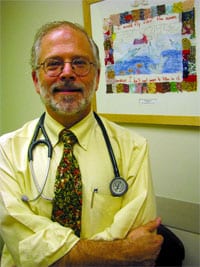Joint Decisions Pediatric Rheumatologist Says Advances Have Profoundly Changed This Sub-specialty
Dr. Peter Blier says it’s not an increase in incidence that has led to a surge in interest — and growing levels of service — in the broad realm of pediatric rheumatology.
Indeed, ailments such as juvenile idiopathic arthritis, lupis, and dermatomyositis remain fairly rare. Rather, he said, it is vast improvement in the ways these disorders are treated, as well as the ability to greatly improve the quality of life for those who are afflicted, that has led to the creation of programs such as Baystate Children’s Hospital’s new initiative in pediatric rheumatology, which Blier now leads.
“There are a number of new injective therapies that are incredibly effective and have given kids and their families their lives back and in ways that we wouldn’t have thought possible before,” said Blier. “We’ve reduced the rate of serious disability and damage to joints in ways that we could only wish were possible 20 years ago.”
As he talked about pediatric rheumatology and the advances that have taken place, Blier, who came to Baystate earlier this year, summoned that well-worn phrase, the one about how children are not simply small adults. They have unique needs and pose their own set of challenges, he told The Healthcare News, adding that he’s spent his career working to address them.
He summed up his interest in medicine and specifically his work with children by saying that he’s long been fascinating by discovering how and why things go wrong — and with devising ways to make them right.
And while his focus is clearly on clinical work, he considers himself perhaps first and foremost a teacher — educating young people and their parents about their bodies and how to better take care of themselves.
“I could never be a teacher — I don’t have enough energy,” joked Blier, who did teach science in a New Jersey middle school for one year and thus speaks from experience. “But I love to teach … it’s a big part of what I do.”
In this, the latest installment of its Today’s Physician series, The Healthcare News talks with Blier about the many changes that have taken place in the sub-specialty of pediatric rheumatology, and why he’s excited to be the forefront of what would have to be considered a new era in the treatment of such diseases.
Not Just Growing Pains
Blier said that early on, he developed a keen interest in research work, but quickly determined that he needed to be at the bedside, or the examining room, and not the “bench,” as he called it.
“I knew I wanted to be around people,” he said, adding quickly that by that, he meant young people.
“It was never going to be anything but pediatrics,” he said of the career path that he would eventually follow. “And I always liked the immune system; I was drawn to work that focused on how it goes wrong, and on finding ways to make it work better.”
Blier attended Harverford College for undergraduate work, majoring in biology, and then Yale University Medical School, where he concentrated in human genetics. He completed his residency in pediatrics at Boston City Hospital and a fellowship in pediatric rheumatology at Yale University/Yale-New Haven Hospital. From 1992 to 1996, he served as a principal scientist at the Department of Immunological Diseases at Boehringer Ingelheim Pharmaceuticals in Ridgefield, Conn.
A long-time attending physician in the pediatrics departments at both Baystate Medical Center and Mercy Medical Center, as well as a consulting physician in rheumatology at Shriners Hospital for Children in Springfield, Blier was most recently a pediatrician with Riverbend Medical Group in Chicopee.
It was in that capacity that he initiated discussions with the now former director of Baystate Children’s Hospital, Edward Reiter, about the need for a formal pediatric rheumatology program at the hospital. The need for such a facility was evident, he explained, noting that while there has long been a pediatric rheumatologist on staff at Shriner’s, there hadn’t been a formal program in that specialty.
And one was needed, he continued, noting that while there are a few such programs in Boston and one in western New York, there is essentially nothing in between.
With the support of Lindsey Grossman, who succeeded Reiter as director of the Children’s Hospital last fall, the new pediatric rheumatology department became reality last February, when Blier came on board.
Since then, he has been ramping up, and, in a several ways, getting word out about the program, which, as he explained, is representative of a nationwide trend to add and improve services in pediatric rheumatology, a phenomenon that has played out over the past two decades or so.
There are now roughly 250 pediatric rheumatologists across the country, and just over 100 programs in that sub-specialty, he said, adding that both numbers are growing each year in response to escalating need.
Blier said that children do in fact suffer from arthritis, but in forms different than those seen in adults, such as osteo-arthritis, gout, and others. Young people contract what’s known as juvenile idiopathic arthritis (JIA), lupus, scleroderma, and other subtypes of arthritis.
The afflictions aren’t new, nor are there many more cases than a decade or a generation ago, he told The Healthcare News, adding quickly that the profound change that has come in this field involves new medications and treatments that greatly improve quality of life.
“Look at pictures from arthritis camps from years ago, and you see kids in wheelchairs and kids who can barely get around,” he said. “You hardly ever see that anymore; the advances have been incredible.”
They’ve come from the kinds of research that Blier said he enjoyed, but ultimately couldn’t make his career.
“One of the most wonderful stories of bench-to-bedside in modern medicine is how people took discoveries on which kinds of white-cell hormones are responsible for triggering diseases and developed ways to inhibit them in experimental models,” he explained, “that then turned into highly effective therapeutic treatments.”
As just one example of the progress that’s been made he referenced an affliction known as dermatomyositis, a connective-tissue disease that is characterized by inflammation of the muscles and the skin. “It used to be frequently fatal, but now … deaths are very, very rare.”
With the advancements in medication have come fewer complications from prescribed treatments, Blier continued, adding that years ago, one of the most common treatments for JIA, once known as juvenile rheumatoid arthritis, was large doses of steroids, which brought with them a number of complications. “Now, we can get away with much lower doses, which greatly improves quality of life for patients.”
While there have been great improvements in this field, there are still a number of challenges, Blier acknowledged, especially in the realm of diagnosis.
“There’s lots of kids whose joints hurt who don’t have arthritis,” he explained. “There isn’t a test you can do, although there’s a common misconception that there is one. Instead, you need to put together the whole story, get all the pieces to the puzzle, and look at when it hurts, why it hurts, and how to make it better.”
Down to His Bones
Blier told The Healthcare News that it’s professionally rewarding to be part of this time of profound change in his chosen field, and he’s excited about what the future will hold.
“It’s amazing the strides we’ve made,” he said. “We’ve come a very long in a relatively short time — and there are more improvements to come.”
Thus, Blier, who all those years ago knew that he was destined to work in pediatrics, is certainly in the place (meaning the right sub-specialty) at the right time.


